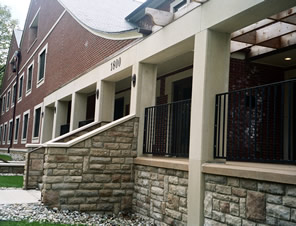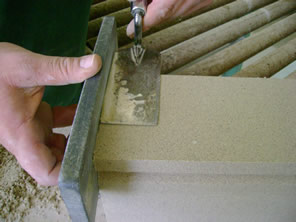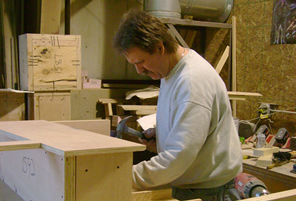

|
Cast
Stone is a highly refined architectural concrete building
unit manufactured to simulate natural cut stone in masonry
applications. Cast Stone is used as an architectural feature,
trim, ornament or facing for buildings or other structures.
Cast Stone is made using white and/or grey cements, manufactured
or natural sands, crushed stone, water, chemical admixtures
and mineral coloring pigments to achieve the desired color
and appearance while maintaining durable physical properties
that stand the test of time. Cast Stone is an excellent
replacement for natural building stones. |
< < < RETURN TO TOP

Cast
stone is most commonly used in a decorative application
similar to natural limestone and other stones. Cast stone
is typically used as an architectural feature, trim,
ornament, or facing. The most commonly used units include
banding, sills, door and window surrounds, coping, quoins,
and water tables. Other less common uses include columns,
balls, medallions and a variety of others that are all
suited to cast stone.
|
< < < RETURN
TO TOP

Cast
Stone has been a prime building material for hundreds
of years. The earliest known use of Cast Stone dates
back to around the year 1138 in France. Cast Stone was
first used extensively in London in the year 1900 and
gained widespread acceptance in America in 1920.
Cast
Stone is generally regarded as the most labor-intensive
of all concrete products' manufacturing processes. Every
aspect of the cast stone process is crucial. It is this
process that allows cast stone to be available in the
variety of
custom designs it is today.
The
process begins with the drafting department. A vast knowledge
of architectural styles and designs, experience,
familiarity
of the manufacturing methods and the techniques of the
masonry contractor are vital to ensuring that a job is
completed
with the highest degree of quality.
The
mold shop is another important step in the process. An
eye for detail and excellence in craftsmanship are
required. Because a variety of materials are available
for use, an
experienced mold maker must know which material will
fit a particular application. Wood is the most commonly
used
material, but fiberglass, steel and rubber are also
better-suited to certain projects. The variety of materials
available
to
build molds with allows the manufacturer the ability
to create cast stone pieces to fit a large range of
different projects.
Molds must be built with a high degree of quality because
that one mold can produce up to 250 pieces. This is
what allows cast stone to become a cost-effective alternative.
After
the piece is removed from the mold, it must be cured.
This curing process is crucial. When cured in
a warm and
moist environment, a compressive strength of 6500
psi or higher is obtained and a water absorption of 6%
or lower;
both exhibiting the strength of cast stone. The surface
layer of cement is removed with an acid wash to reveal
the white
stone aggregates creating a look that is similar
in
color, texture and appearance to natural stone.
This
process creates a vast array of customization options.
Because of the customization available with
cast stone,
it can add the most personalized and unique element
to the project.
|
< < < RETURN
TO TOP

The
two casting methods used by Superior Precast are
the “Vibrant Dry Tamp" method (otherwise
known as “dry cast”) and the "Wet
Cast" method. Both methods are required to
adhere to the highest standards. Cast stone is
usually produced with a low water-to-cement ratio
mixture that has a "dry" consistency,
yielding higher compressive strengths than low-slump
concrete. The mixture of earth moist, zero-slump
concrete is consolidated into a mold until it is
densely compacted using an air driven tamping device.
It is ready for immediate removal from the form.
This method allows a great number of pieces to
be cast from a single mold in a work day and enables
fast-track production. The dry cast process guarantees
total absence of bug holes and a look that is very
similar to natural stone.
Each
method requires a carefully proportioned mix design.
Our mix designs consist of graded and washed natural
gravel and sand combined with crushed limestone to
meet the latest requirements of ASTM C 33. The mixtures
are proportioned for maximum density. White cement
is used as the base for all of our standard colors.
A mixture of Grey Portland cement, white cement and
coloring pigments are used to achieve a variety of
other colors. Numerous admixtures are available today
to be used in the dry cast method. We add a waterproofing
admixture to increase strength and reduce absorption
for improved freeze-thaw durability. An admixture
is also added to wet cast concrete to allow it
to withstand
numerous freeze-thaw cycles for long-lasting durability.
|


|
< < < RETURN
TO TOP

Today,
Cast Stone is considered a highly versatile, long-lasting,
cost-effective and truly superior alternative to
natural cut stone. Combined with its ability to
simulate a variety of natural stones, cast stone
offers many positive characteristics and advantages
over cut stone. It is readily available with a
relatively short lead time – an average of
four to six weeks after the approval of shop drawings.
Perhaps most importantly, it is pleasing to the
eye.
|
Advantages:
- Integrally
reinforced with steel
- Repetitive
profiles allow manufacturing at a fraction of
the cost
- Consistent
quality
- Weathers
better because the process is controlled
- Offers
a wide range of precise colors and a variety
of shapes
- Easily
cut to length in the field
- Deliver
a time-tested freeze-thaw durability
- Ability
to replication deteriorating stone on historical
buildings for restoration
|
Limitations:
- Should not be used to serve a structural
function
- Sizes and connections should always be
within the range of work required by the mason
contractors
- The
dry cast method does not work well with large
panels – the optimum size is around
3 5/8” x
2’ x 5’
|
< < < RETURN
TO TOP

Cast
stone is a Portland cement-based product manufactured
with high quality fine and coarse aggregate. Simulated
stone or other products that attempt to replicate
the look of natural stone are less durable and
not nearly as well time-tested. Using a high percentage
of fine aggregate creates a very smooth, consistent
texture for the products being cast, allowing them
to resemble natural cut stone. In general, cast
stone will cost less than natural stone.
|
|
Cast Stone |
Limestone |
Architectural Precast Concrete |
Component: |
Portland
cement, fine crushed limestone, sand, color |
Carbonated
lime |
Sand,
cement, larger aggregates |
Size of Aggregate: |
3/8"
or less |
N/A |
3/8"
to 3/4" |
Structural Function: |
Limited.
Can be reinforced. |
Non-structural.
Cannot be reinforced. |
Structural
or Non. Can be reinforced |
Standard Uses: |
Architectural
features, trim, ornament. |
Architectural
features, trim, ornament. |
Architectural
structural or non-structural panels. |
Anchor Attachment: |
Pre-formed
anchor slots |
Cut
anchor slots |
Added
to piece as it is poured and can be installed
at the job site. |
Surface Texture:
|
Fine
grain - smooth |
Fine
grain |
Exposed
aggregate or other finishes |
Creation of Shape:
|
VDT
Method - Numerous pieces in a day |
Mined
and cut |
Wet
Cast - forms removed the next day |
Color Availability:
|
Unlimited |
White,
buff, gray tones |
Unlimited |
Compressive Strength:
|
6,500
psi minimum. ASTM C1194 |
4,000
psi minimum. ASTM C170 |
5,000
psi minimum. ASTM C39 |
Water
Absorption:
|
6%
Maximum |
7.5%
Maximum |
7%
Maximum |
Bug
Holes or Air Voids:
|
No |
No |
Yes |
Metal
Reinforcing:
|
Yes |
No |
Yes |
Weight
/ Cubic Foot:
|
140 |
144 |
145 |
Keys
to Efficiency: |
Repeated
units, one flat and unexposed surface |
Simple
profiles, shipping costs |
Larger
structural pieces |
|
< < < RETURN
TO TOP

The
pricing of cast stone depends on various factors
including the job size, repetition of pieces and
mold reuse, the complexity of the job, size and
design of the piece, how many sides of the piece
are exposed and color.
Size:
Rather than cost per lineal foot or cost per square
foot, the wide range of sizes that can be made
in Cast Stone makes it more convenient to view
cost in terms of cubic feet per piece. The ideal
unit cost (per cubic foot) is achieved when individual
piece sizes are 1.5 to 2.0 cubic feet. The ideal
length for straight pieces such as copings, sills,
banding is between 4' to 6'.
Piece
Design:
By including one flat unexposed side in the design
of the individual piece, production time, curing
time and costs will be reduced to a minimum. Typical
profiles with one flat unexposed side include base,
water table, banding, sills, header, and coping.
Some pieces are designed with more than one flat
unexposed side, which causes costs to increase due
to the intricate mold required and the additional
production time. The more complicated a piece is,
the higher the cost will be.
Profile
Repetition:
Cost can be lowered tremendously the more times
that an individual mold can be used over a production
run. Different lengths of the same profile can be
easily achieved by using an adjustable block in the
mold during the production process.
Profiles:
Cast stone can be molded to a variety of shapes.
Profiles with curves, radius, bevels and chamfers
can be built into the mold at a minimal cost.
Ornamentation:
Highly intricate designs with heavy mold work or
molds that need to be made from a material other
than wood will add to the cost.
Color:
The more chromatic the desired color, the more each
piece costs. Standard colors are listed in the Product
Catalog section and are at no additional cost. Colors
other than those listed will raise the cost.
|
< < < RETURN
TO TOP
|
|
 |